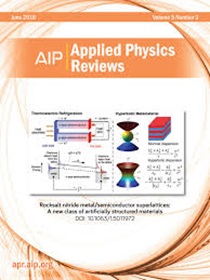A review on temperature coefficient of frequency (TCf) in resonant microelectromechanical systems (MEMS)
IF 11.6
1区 物理与天体物理
Q1 PHYSICS, APPLIED
引用次数: 0
Abstract
Microelectromechanical systems (MEMS) have emerged as highly attractive alternatives to conventional commercial off-the-shelf electronic sensors and systems due to their ability to offer miniature size, reduced weight, and low power consumption (i.e., SWaP advantages). These features make MEMS particularly appealing for a wide range of critical applications, including communication, biomedical, automotive, aerospace, and defense sectors. Resonant MEMS play crucial roles in these applications by providing precise timing references and channel selections for electronic devices, facilitating accurate filtering, mixing, synchronization, and tracking via their high stability and low phase noise. Additionally, they serve as key components in sensing applications, enabling detection and precise measurement of physical quantities for monitoring and control purposes across various fields. Temperature stability stands as a paramount performance specification for MEMS resonators and oscillators. It relates to the responsivity of a resonator's frequency to temperature variations and is typically quantified by the temperature coefficient of frequency (TCf). A constant and substantially large absolute TCf is preferred in MEMS temperature sensing applications, while a near-zero TCf is required for timing and other MEMS transducers that necessitate the decoupling of temperature effects on the resonance frequency. This comprehensive review aims to provide an in-depth overview of recent advancements in studying TCf in MEMS resonators. The review explores the compensation and engineering techniques employed across a range of resonator types, utilizing diverse materials. Various aspects are covered, including the design of MEMS resonators, theoretical analysis of TCf, temperature regulation techniques, and the metallization effect at high temperatures. The discussion encompasses TCf analysis of MEMS resonators operating in flexural, torsional, surface, and bulk modes, employing materials such as silicon (Si), lithium niobate (LiNbO3), silicon carbide (SiC), aluminum nitride (AlN), and gallium nitride (GaN). Furthermore, the review identifies areas that require continued development to fully exploit the TCf of MEMS resonators.谐振式微机电系统(MEMS)中频率温度系数(TCf)研究进展
微机电系统(MEMS)已经成为传统商业现成电子传感器和系统的极具吸引力的替代品,因为它们能够提供微型尺寸、减轻重量和低功耗(即SWaP优势)。这些特点使得MEMS特别适合广泛的关键应用,包括通信、生物医学、汽车、航空航天和国防部门。谐振MEMS在这些应用中发挥着至关重要的作用,为电子设备提供精确的定时参考和通道选择,通过其高稳定性和低相位噪声促进精确滤波,混合,同步和跟踪。此外,它们作为传感应用的关键组件,能够检测和精确测量物理量,用于各个领域的监测和控制目的。温度稳定性是MEMS谐振器和振荡器最重要的性能指标。它与谐振器频率对温度变化的响应性有关,通常用频率温度系数(TCf)来量化。恒定且相当大的绝对TCf在MEMS温度传感应用中是首选,而时序和其他MEMS换能器需要接近零的TCf,这需要对温度对谐振频率的影响进行解耦。本文旨在深入概述MEMS谐振器中TCf的最新研究进展。该评论探讨了补偿和工程技术采用了一系列谐振器类型,利用不同的材料。包括MEMS谐振器的设计、TCf的理论分析、温度调节技术和高温下的金属化效应等各个方面。讨论包括在弯曲、扭转、表面和块体模式下工作的MEMS谐振器的TCf分析,采用硅(Si)、铌酸锂(LiNbO3)、碳化硅(SiC)、氮化铝(AlN)和氮化镓(GaN)等材料。此外,该综述确定了需要继续发展的领域,以充分利用MEMS谐振器的TCf。
本文章由计算机程序翻译,如有差异,请以英文原文为准。
求助全文
约1分钟内获得全文
求助全文
来源期刊

Applied physics reviews
PHYSICS, APPLIED-
CiteScore
22.50
自引率
2.00%
发文量
113
审稿时长
2 months
期刊介绍:
Applied Physics Reviews (APR) is a journal featuring articles on critical topics in experimental or theoretical research in applied physics and applications of physics to other scientific and engineering branches. The publication includes two main types of articles:
Original Research: These articles report on high-quality, novel research studies that are of significant interest to the applied physics community.
Reviews: Review articles in APR can either be authoritative and comprehensive assessments of established areas of applied physics or short, timely reviews of recent advances in established fields or emerging areas of applied physics.
 求助内容:
求助内容: 应助结果提醒方式:
应助结果提醒方式:


